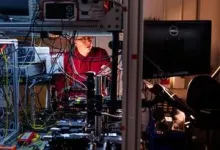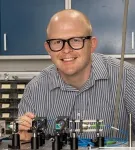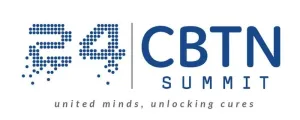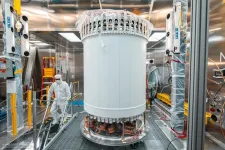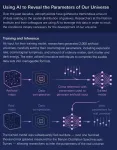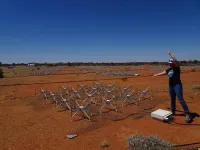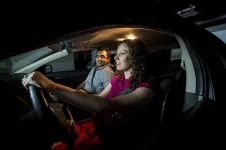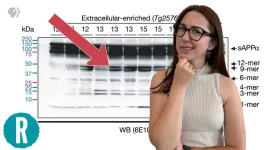(Press-News.org) ALBUQUERQUE, N.M. — Sandia National Laboratories and Arizona State University, two research powerhouses, are collaborating to push the boundaries of quantum technology and transform large-scale optical systems into compact integrated microsystems.
Nils Otterstrom, a Sandia physicist specializing in integrated photonics, is at the forefront of scaling down optical systems to the size of a chip. This innovation offers performance advantages and scalability for an array of applications from advanced computing to secure communications.
“Integrated photonics takes optical systems that are macroscale and makes them microscale,” said Otterstrom, who earned his doctorate in applied physics from Yale and joined Sandia as a Harry S. Truman fellowship recipient. “What we do in integrated photonics is develop novel devices and explore device physics to provide all the functionalities that we need to do fundamental research and create next-generation quantum microsystems. The world-class fabrication capabilities and high degree of customizability we have here at Sandia in the Microsystems Engineering, Sciences and Applications complex, or MESA, uniquely position us to impact the most cutting-edge science and technology.”
Quantum Collaborative
Otterstrom has been collaborating with Senior Director of Quantum Networking at Arizona State University Joe Lukens. Lukens is the leading expert on using the frequency of light to carry quantum information for quantum computing and networking systems.
This effort was recently formalized through a new Cooperative Research and Development Agreement funded by the Quantum Collaborative. The Quantum Collaborative brings together academic and research institutions — including national labs — to advance quantum information and technology research, as well as education and workforce development.
“The inspiration for the Quantum Collaborative is the recognition that the future is quantum. If we’re going to be successful, it cannot be done by single investigators or even single institutions; it’s just not going to be possible,” Lukens said. “The collaborative is an intentional network of like-minded individuals who are interested in building up quantum information technology, and it’s a way for us to connect and work together.”
The state of Arizona funds the Quantum Collaborative and Arizona State University manages the initiative.
From bulky to chip
Before the agreement with Sandia, Lukens focused on fiber-optic systems for his work in frequency-bin quantum information processing. He explained that qubits exist in all sorts of platforms, including photonics.
“In the frequency approach, your qubit is a photon that can possess two different wavelengths, or colors of light simultaneously,” Lukens said. “A zero corresponds to one color, and one corresponds to the other color. That encoding is advantageous for quantum communications. It’s transmitted well in optical fiber.”
The work was done previously with commercial light-wave components on optical tables.
“We’re using big bulky systems. They have high losses of photons, they are very expensive and they take a lot of space,” Lukens said. “I think I’ve done all I can do with tabletop devices in frequency-bin encoding.”
This is where Sandia’s resources for integrated photonics come into play.
“Sandia has one of the most flexible foundries in the world, not only in microelectronics but also in photonics,” Lukens said, referring to the MESA complex. “Sandia can fabricate small photonic integrated circuits that can realize the same capabilities as a big square meter-size optical table.”
Sandia’s National Security Photonics Center offers a wide variety of component and platform technologies, with a portfolio of more than 50 issued patents in integrated photonics.
Quantum photonics components
Spatial beam splitters, which take photons and split them in two directions, are fundamental components in quantum photonics.
“In this frequency encoding paradigm, we need to create special types of beam splitters that instead take one color of light and split it into two colors,” Otterstrom said. “What we’ve developed here at Sandia, in collaboration with professor Peter Rakich’s team at Yale University, are these very efficient novel phase modulator devices.”
The devices are based on suspended silicon waveguides that convey light and gigahertz soundwaves, which are generated by co-integrated aluminum nitride electro-mechanical transducers.
“The result is highly flexible optomechanical structures that acousto-optically split a photon into multiple frequencies. This allows you to do quantum information processing on a much higher dimensional space,” Otterstrom said. “You can think about it as the light’s color can actually carry the quantum information.”
What’s next?
Lukens said his goal is to move work from proof-of-principle experiments to deployment in quantum networks.
“In order to do that, we need systems with lower loss than what we can achieve today with commercial devices, and we need systems that are a bit cheaper,” Lukens said. “If we can realize those capabilities on chip, now we’re talking about a much more practical and plausible way to do quantum networking.”
Otterstrom has been guiding Lukens to acquire components, such as microscopes and optical mounts, to use the Sandia-built photonic integrated circuits in a testbed at the university’s lab.
A Grand Challenge
The collaboration is paying off. Sandia’s Laboratory Directed Research program has awarded $17 million to advance the team’s work in frequency-based quantum photonics. The funding comes in the form of a Grand Challenge program called Error-Corrected Photonic Integrated Qubits, or EPIQ.
“Without the partnership between Sandia and Arizona State University, we would probably not have the EPIQ Grand Challenge in its current shape and form,” said Paul Davids, the principal investigator on the project. “Nils’ outreach to Joe Lukens began our first foray into the ideas around frequency-encoded photonic qubits. His thoughtful leadership in this area and Joe Lukens’ prior work and expertise are central to the EPIQ Grand Challenge.”
Otterstrom said the funding will enable large-scale implementation and integration of the device physics explored in the early collaboration with Arizona State University to create a useful photonic qubit that can be error-corrected.
SWAP Hub
In addition to participating in the Quantum Collaborative, Sandia offers the MESA complex’s microelectronics prototyping capabilities as a core partner of the Southwest Advanced Prototyping Hub. SWAP Hub, which is also led by Arizona State University, is one of eight Microelectronics Commons Hubs across the country. The Microelectronics Commons is funded by the CHIPS and Science Act enacted by Congress to jumpstart American competitiveness in the semiconductor industry and reduce dependence on foreign suppliers.
Sandia National Laboratories is a multimission laboratory operated by National Technology and Engineering Solutions of Sandia LLC, a wholly owned subsidiary of Honeywell International Inc., for the U.S. Department of Energy’s National Nuclear Security Administration. Sandia Labs has major research and development responsibilities in nuclear deterrence, global security, defense, energy technologies and economic competitiveness, with main facilities in Albuquerque, New Mexico, and Livermore, California.
Sandia news media contact: Kenny Vigil, kcvigi@sandia.gov, 505-537-1528
END
Lighting the way for quantum innovation
Sandia collaboration combines integrated photonics and light-wave frequency for novel quantum information processing
2024-08-26
ELSE PRESS RELEASES FROM THIS DATE:
Spin squeezing for all
2024-08-26
Nothing in science can be achieved or understood without measurement. Today, thanks to advances in quantum sensing, scientists can measure things that were once impossible to even imagine: vibrations of atoms, properties of individual photons, fluctuations associated with gravitational waves.
A quantum mechanical trick called “spin squeezing” is widely recognized to hold promise for supercharging the capabilities of the world’s most precise quantum sensors, but it’s been notoriously difficult to achieve. In new research, Harvard physicists describe how they’ve put spin squeezing ...
NSF funds research on the effects of evolution and food webs in climate change response
2024-08-26
Colorado State University is leading a new interdisciplinary research project into the ways predators and prey in sensitive ecosystems may react to climate change based on their physiology, genetics and relationships to each other.
Led by Professor Chris Funk in the Department of Biology, the project is funded by the National Science Foundation’s Organismal Response to Climate Change program and will focus on interactions between cutthroat trout and tailed frogs in Pacific Northwest streams. This approach is one of the first times researchers have tried to test both the effects of evolution and ...
Children's Brain Tumor Network hosts 2024 CBTN Summit to transform scientific research and patient care
2024-08-26
What:
The 2024 CBTN Summit hosted by the Children's Brain Tumor Network (CBTN) assembles the brightest minds in Pediatric Brian Tumor research for this annual conference. The event is free but attendees must register in advance.
Register at network.cbtn.org/cbtn-summit
Where:
In person at AWS Headquarters
Amazon WAS16 Aurora, 1770 Crystal Dr, Arlington, VA 22202
Virtual attendance available worldwide.
When:
October 9-11, 2024
Why:
This event is an opportunity ...
Long-term prognosis of patients with myocarditis attributed to COVID-19 mRNA vaccination, SARS-CoV-2 infection, or conventional etiologies
2024-08-26
About The Study: Patients with post–COVID-19 mRNA vaccination myocarditis, contrary to those with post–COVID-19 myocarditis, show a lower frequency of cardiovascular complications than those with conventional myocarditis at 18 months. However, affected patients, mainly healthy young men, may require medical management up to several months after hospital discharge.
Corresponding Authors: To contact the corresponding authors, email Laura Semenzato, MSc (laura.semenzato@assurance-maladie.fr) and Mahmoud Zureik, MD, PhD (Mahmoud.ZUREIK@ansm.sante.fr).
To access the embargoed study: Visit our For The ...
LZ experiment sets new record in search for dark matter
2024-08-26
Figuring out the nature of dark matter, the invisible substance that makes up most of the mass in our universe, is one of the greatest puzzles in physics. New results from the world’s most sensitive dark matter detector, LUX-ZEPLIN (LZ), have narrowed down possibilities for one of the leading dark matter candidates: weakly interacting massive particles, or WIMPs.
LZ, led by the Department of Energy’s Lawrence Berkeley National Laboratory (Berkeley Lab), hunts for dark matter from a cavern nearly one mile underground at the Sanford Underground Research Facility in South Dakota. The experiment’s new results explore weaker dark matter interactions ...
Astrophysicists use AI to precisely calculate universe’s ‘settings’
2024-08-26
The standard model of the universe relies on just six numbers. Using a new approach powered by artificial intelligence, researchers at the Flatiron Institute and their colleagues extracted information hidden in the distribution of galaxies to estimate the values of five of these so-called cosmological parameters with incredible precision.
The results were a significant improvement over the values produced by previous methods. Compared to conventional techniques using the same galaxy data, the approach yielded less than half ...
SETI Institute starts first low frequency search for alien technology in distant galaxies
2024-08-26
August 26, 2024, Mountain View, CA -- The SETI Institute, the Berkeley SETI Research Center and the International Centre for Radio Astronomy Research announced a groundbreaking study using the Murchison Widefield Array (MWA) in Western Australia. Led by Dr. Chenoa Tremblay of the SETI Institute and Prof. Steven Tingay of Curtin University, this research is the first to search for signs of alien technology in galaxies beyond our own, focusing on low radio frequencies (100 MHz). This innovative study used the MWA’s large field of view (FOV), allowing the team to cover about 2,800 galaxies in one observation, of which 1300 we know the distance to. Usually, the search for extraterrestrial ...
Bicycle rolling-stop laws don’t lead to unsafe behavior by riders or motorists, research shows
2024-08-26
CORVALLIS, Ore. – Laws that let bicyclists treat stop signs as yield signs lead neither riders nor motorists to act unsafely, according to a groundbreaking Oregon State University study.
The project by OSU College of Engineering researchers featured a novel experimental technique – linking separate bicycle and motor vehicle simulators – and the findings are important as more and more states consider bicycle rolling-stop legislation, said David Hurwitz, the study’s leader.
“It required fully connecting two independent simulators, running subjects in pairs simultaneously and having each subject interacting with an avatar of the other in a shared virtual ...
How a retracted paper affected the course of Alzheimer’s research (video)
2024-08-26
WASHINGTON, Aug. 26, 2024 — In June 2024, a landmark Alzheimer's research paper was retracted due to fraud allegations. Did we waste billions of dollars and thousands of hours of scientists’ time? Maybe not. There are now two potentially helpful drugs on the market targeting the subject of the paper: amyloid beta. This video breaks down the amyloid-beta hypothesis, the fraud itself and where we go from here.
Reactions is a video series produced by the American Chemical Society and PBS Digital Studios. Subscribe to Reactions and follow us on X, formerly Twitter @ACSReactions.
The American Chemical ...
Genotype Matters: Tailored screening for germline CHEK2 variants
2024-08-26
“In our study, we postulated that these differences were driven by three common low-risk (LR) missense variants: p.I157T, p.S428F, and p.T476M, all of which have a BC odds ratio of <1.4.”
BUFFALO, NY- August 26, 2024 – A new editorial was published in Oncotarget's Volume 15 on July 10, 2024, entitled, “Genotype matters: Personalized screening recommendations for germline CHEK2 variants.”
Recognized as a moderate-risk gene, CHEK2—responsible for encoding the CHK2 protein, ...
LAST 30 PRESS RELEASES:
National poll: Less than half of parents say swearing is never OK for kids
Decades of suffering: Long-term mental health outcomes of Kurdish chemical gas attacks
Interactional dynamics of self-assessment and advice in peer reflection on microteaching
When aging affects the young: Revealing the weight of caregiving on teenagers
Can Canada’s health systems handle increased demand during FIFA World Cup?
Autistic and non-autistic faces may “speak a different language” when expressing emotion
No clear evidence that cannabis-based medicines relieve chronic nerve pain
Pioneering second-order nonlinear vibrational nanoscopy for interfacial molecular systems beyond the diffraction limit
Bottleneck in hydrogen distribution jeopardises billions in clean energy
Lung cancer death rates among women in Europe are finally levelling off
Scientists trace microplastics in fertilizer from fields to the beach
The Lancet Obstetrics, Gynecology, & Women’s Health: Taking paracetamol during pregnancy does not increase risk of autism, ADHD or intellectual disabilities, confirms new gold-standard evidence review
Taking paracetamol during pregnancy does not increase risk of autism, ADHD or intellectual disabilities
Harm reduction vending machines in New York State expand access to overdose treatment and drug test strips, UB studies confirm
University of Phoenix releases white paper on Credit for Prior Learning as a catalyst for internal mobility and retention
Canada losing track of salmon health as climate and industrial threats mount
Molecular sieve-confined Pt-FeOx catalysts achieve highly efficient reversible hydrogen cycle of methylcyclohexane-toluene
Investment in farm productivity tools key to reducing greenhouse gas
New review highlights electrochemical pathways to recover uranium from wastewater and seawater
Hidden pollutants in shale gas development raise environmental concerns, new review finds
Discarded cigarette butts transformed into high performance energy storage materials
Researchers highlight role of alternative RNA splicing in schizophrenia
NTU Singapore scientists find new way to disarm antibiotic-resistant bacteria and restore healing in chronic wounds
Research suggests nationwide racial bias in media reporting on gun violence
Revealing the cell’s nanocourier at work
Health impacts of nursing home staffing
Public views about opioid overdose and people with opioid use disorder
Age-related changes in sperm DNA may play a role in autism risk
Ambitious model fails to explain near-death experiences, experts say
Multifaceted effects of inward foreign direct investment on new venture creation
[Press-News.org] Lighting the way for quantum innovationSandia collaboration combines integrated photonics and light-wave frequency for novel quantum information processing

